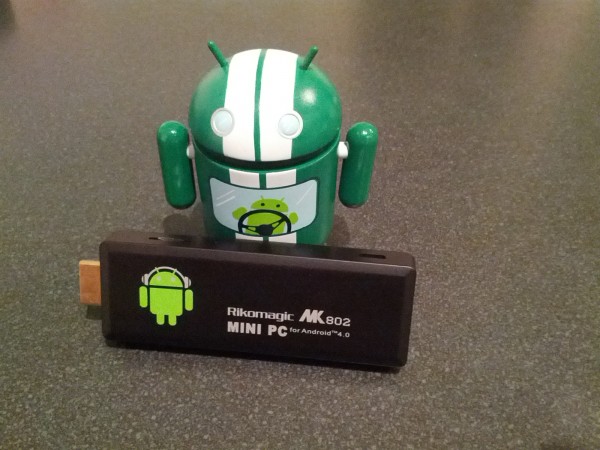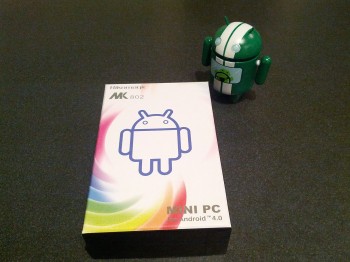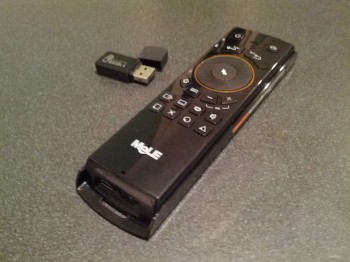
For a while now, one of the main uses of most devices I purchase has been media playback. The question I ask of a new device isn’t “Can it play Doom?” – I’m more interested in playing videos properly.
Over time these devices have gotten cheaper, more affordable and more functional. This practice dates back 5+ years, when I was buying cheap DVD players that could read data discs and play back video files, through portable Archos media players with TV-out docks (pre-Android days), an Xbox with XBMC, media center PCs up to my current player of choice – the Boxee Box.
Last week I noticed that local deal-a-day site Zazz was offering an Android Mini PC for sale at $79. I bought it with barely a second thought after reading an article in last month’s APC about using the devices as a cheap media center. Thanks to Zazz’s speedy shipping practices, my Mini PC arrived yesterday. Here’s a first look at the device.
Packaging
What’s included?
- Rikomagic MK802II
- USB OTG Adapter
- USB to Micro USB cable (1 foot)
- HDMI extension cable (1 foot)
- Instruction manual
The Rikomagic presents itself in a fairly densely packed box of tricks. The color-printed box is made of sturdy cardboard (thicker than your average phone box) which is a bit larger than a Galaxy Nexus. Inside you’ll find the device jammed into a piece of foam with a cutout just the right size for the device. Underneath, a small cardboard compartment holds the USB and HDMI cables and the USB OTG adapter.
It’s a nice enough package, but there’s no mistaking the “cheap Chinese manufacturer” feel.



Hardware
The device itself looks like an oversized USB stick, and indeed confuses onlookers who think the HDMI connector is a USB connector, and then don’t understand how everything works.


There’s no power adapter – the device is powered via a Micro USB port. Zazz thoughtfully included a wall adapter with two 2A USB ports on it.
To connect input devices you’ll need to use the single full-size USB port. It might be possible to attach a hub, but I haven’t tried – you would probably need to use a powered hub, too.
Finally, there’s a USB On-The-Go adapter and another Micro USB port you can use it with, and the device accepts Micro SD cards.

All-up, the device looks a bit less elegant and a bit more Medusa when everything’s connected. This isn’t a deal-breaker if it’s going to sit behind your TV, but if you want everything neat and tidy you’d best look elsewhere.
Starting Up
On boot, you get a quick flash of a colourful screen with a CG rendered Android logo and an Android bot. This disappears quickly and is replaced by a screen with a Rikomagic logo and an Android that moves up and down, then glows as the system boots.
Bootup time is pretty fast – about 20 seconds.
Input
I also purchased a “FLY 10” Air Mouse / Wireless Keyboard / Remote Control with the device in the same Zazz sale.


This remote control is similar to the Boxee remote in that it has buttons and navigation controls on the front, and a keyboard on the back. It’s larger than the Boxee remote, which makes the keyboard a bit easier to use. Unlike the Boxee keyboard, the Caps and Fn keys are sticky – you press them once to turn them on and again to turn them off (the Boxee remote requires you to hold the modifier keys in, which makes typing a sentence in ALL CAPS quite a chore).
The FLY 10 is not an infrared remote. Like many wireless keyboard/mouse combos, it connects over 2.4 Ghz wireless to a USB receiver, which is plugged into the Rikomagic’s full-size USB port.
Android detects that a mouse is available and shows a (fairly ugly, actually) blue pointer on-screen. From time to time the FLY goes to sleep and the pointer disappears, although I couldn’t find a way to make it go away during media playback. I suppose you could turn it off, but that seems like overkill.
The FLY10’s mouse function is run by a gyroscope inside the device, so you have to move it in the air in front of you to move the mouse pointer around the screen. This feels rather like a Wiimote, until you realise you don’t have to point the device at the screen. It feels like the sensitivity could be just a little higher.
While the FLY 10’s keyboard works fine in all Android text-input fields, I couldn’t find a way to stop the onscreen keyboard in the OS. There are some 3rd party options available like Null Keyboard that just show no keyboard.
The FLY10 has a lot of buttons on its face. At top there’s Power and Wake, below that there’s a circular arrangement of buttons around a D-pad with a centre select / left-click button – above there’s Enter and Back, and below there’s Android Home, Android Menu, and Volume Up/Down buttons. Below that there’s a bank of 8 (2 rows of 4) buttons with varying symbols that seem to be mapped to perform a few functions on the Rikomagic like output selection and Mute, and the final four buttons which have configurable shortcut functions.
Getting around the system with the FLY10 takes some getting used to. Android relies so much on touch for its user experience that, when you remove touch from the equation, everything seems a little less intuitive. Textfields with autocomplete functions select the item under the mouse pointer rather than the item you think is selected. It took me a while to realise I could click-and-drag to scroll up and down a list – and that movement isn’t really so pleasant when you’re waving a remote through the air.
Android Customisations
The home screen arrangement is standard – you’re looking at the centre screen of 5 home screens, complete with the Tron-style transitions between screens we’re familiar with from Honeycomb is pretty sparse with three icons – Browser, FileManager and Settings.
It’s not stock Android, but it’s close. Sort of. There are some additional icons on the bottom of the screen:

Left to right you have Back, Home, Multitask, Vol -, Vol +, Power Off, Full Screen and a standard menu button. Interestingly, since there’s no physical power button on the unit you can’t easily take a screenshot. The UI is presented in Android’s large-screen format, so it’s like a 10-inch tablet with soft buttons on the bottom-left, clock and settings to the bottom-right, app drawer icon top-right and Google search top-left.
The settings menu has had a few changes. There’s a new Ethernet option under Networks > More, and while the device doesn’t have mobile data there’s still a section for Mobile Network Settings. Under Storage, there’s a new “MUTIL MEDIA” section that contains settings for Media Scanning on SD & USB and something to do with “Blu Ray Directory Play Mode” that doesn’t seem to be mentioned in the manual.
Internal storage seems quite slow. Bringing up Settings > Device > Storage showed “Calculating…” next to each type of content for a few minutes. I’m assuming the internal storage is partitioned because “INTERNAL STORAGE” shows up twice – once an area of 504 MB size with “1.61 TB” of space taken up by Apps (no, really) and another with 2.3 GB of space. Interestingly this page also shows “EXTSD”, “USBHOST0”, “USBHOST1” and “SATA”, although each section says “Insert an SD card for mounting”.
Under Language & Input, you can find settings allowing you to change the shortcut functions on the remote control.
Perhaps the most interesting change to Settings is the expansion of options in the Display page. This now has Contrast and Saturation controls, along with “screen adaption” which is apparently used to control the screen size used for some games. I couldn’t find any mention of this in the documentation, and it didn’t seem to offer many options. The most interesting thing in the Display menu would have to be the new “Display output mode” section, which allows you to change the output signal – 480 I/P, 576 I/P, 720P 50/60hz, 1080I 50/60hz and 1080P 24/50/60hz are offered as options (NTSC and PAL are also there, but when I selected NTSC the device crashed – oops). This unit can output its signal to pretty much anything as long as it takes HDMI.
Applications
Notably, Flash is included. I tried ABC iView and SBS On Demand and while I was able to play video in the browser from SBS, iView’s UI was too large to fit on-screen in the default browser. Dolphin HD correctly entered fullscreen mode on launching the site, however I was unable to play video (always “Loading…” – however, I was also unable to play video on my Mac).
Super-HD Player seems aimed at playback of local files. The UI has options to display media by Albums, Locations, People and Times. It’s a curious choice for media playback on a device with so little internal storage. The icon for the player also has the lettering ‘2160P’, so perhaps that’s a clue as to the types of file it’s intended to decode. As it is, it’s kind of useless.
FileManager is a custom-built file browser. While it’s somewhat XBMC-like in its navigation, it includes support for SMB/CIFS shares on your network and will load and play videos. The app is mapped to one of the custom shortcuts by default, so it seems like it’s intended to be the main way for you to consume media on the box.
The device has access to the Play Store, so you can sign in and download apps. It’s notable however that you can’t install Chrome from the Play Store. It is possible to install a downloaded APK, however anecdotal evidence from the Rikomagic forums suggests that Chrome doesn’t perform very well on the device. A shame. I was able to install YouTube and Maps, but not Twitter.
Media Performance
The bad news: Getting to media stored on your network is annoying. The FileManager application doesn’t remember your favourite shares and directories, so your only option is to go Network Neighbourhood > Workgroup > Device > Share and navigate through your directory structure from there.
Once you get there, playback of 720p MKV files over wifi works well, but like other media players it can struggle with scenes with a lot of movement (explosions, HBO’s logo, etc).
The media player app also has an interesting UI with its own quirks, including ambigious icon design and non-dismissal of popup menus. Getting rid of the mouse pointer during media playback also seems to be something you’ll have to experiment with.
You could install other apps to handle media playback. I’m considering Plex, but it requires custom server software on my NAS, and I’m not sure I want to go down that path. Some further investigation is required in this area.
Thoughts
Can this take over media playback duties from my Boxee Box? Probably not. It’s difficult to get around the UI and the bare-bones nature of the File Manager will annoy me before the week is out. With some alternatives from the Play Store, the answer will be maybe. I have a NAS on my network which houses all my media files, so a media player that supports playback from SMB/CIFS shares over wifi is what I need.
So, what purpose can this serve? Perhaps a cheap and cheerful media player for the kids’ playroom where it’s tucked away behind the TV, or a portable device you can take to a friend’s place to watch something.
Regrets? I have a few, but purchasing this device isn’t one of them.





Hi Jason I found that playing my files from my networked HDD didn’t work with the built in file manager, but some other filemanagers from the Play store worked fine. ES File Manager worked very well, and I can create shortcuts to my networked drive (just a regular USB box connected to an Apple Airport Extreme) that work perfectly. I’ve seen a few hiccups on HD video, but that might be the Wifi or the computer, haven’t tried to isolate it. Will be trying other media players such as VLC in the next day or so. My kids love playing… Read more »
Could you review the dual core UG802?
Would love to know how well plex works, its my media centre of choice. I imagine it would be a pretty sweet alternative.
Plex works well, I have one of these and thinks it’s a nice little device, though the dual core version ships soon, it’s called the UG802 but is a little more expensive…
sounds like an interesting product – my wife wants to be able to stream media to the little lcd in the kitchen while she’s cooking… and this might be the solution!
“Zazz thoughtfully included a wall adapter with two 2mAh USB ports on it.”
I do hope those are 2A USB ports…
How embarrassing! Yes, they are. Post has been updated 🙂
How’s it work as a DLNA client?
There’s a few apps around for that, which you can combine with the VLC media player.
Is it powerful enough to play movies sitting on a DLNA server?
Exactly what I wanted to know – I’ve been pretty darned happy with BubbleUPnP for connecting and controlling playback and discovering media sources around my LAN.
In fact just last night I was wondering when the future became now as I could move music and videos from my tablet to my phone, to my TV to my Laptop, all from one little touch screen.
I was playing 720p MKVs off my NAS drive (a WD MyBookWorld) and they played OK over Wifi.
I don’t generally use DLNA because I find it simpler at a network level to just play files from an SMB/CIFS share (Boxee can also access AFP shares).
I’ll do a bit more research on DLNA and report back.
Cool.
I have a little QNAP NAS, which has a built in DLNA server.
It works fine with the Playstation attached to the big TV in the living room, but I’d like something cheap to attach to the telly in the kitchen and our bedroom (is that too many TVs for one house?).
Something like this would do the job.